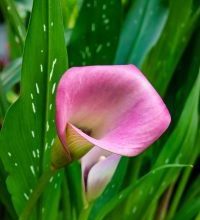Types of Irrigation | Advantages of each Irrigation System for the Garden
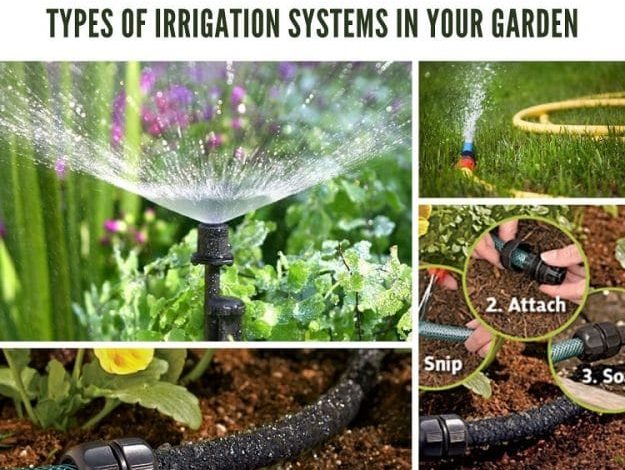
Plant watering is one of the key aspects of gardening. As you may know, there are different types of irrigation that we can use. Today we will talk about the most important ones, such as drip irrigation, sprinkler irrigation or exuding tape, and we will see the main advantages of each irrigation system.
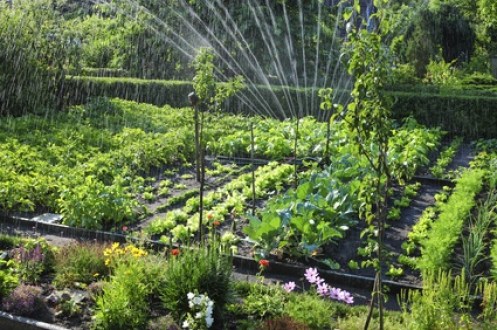
Types of irrigation for the orchard and advantages
Although we have already seen in other Agrohuerto articles some types of irrigation and the most important aspects that we must take into account when choosing them (see « Planning irrigation in the garden «), today we are going to make a summary of the main types of irrigation that can be used to provide water to our crops.
1. Drip irrigation
It is perhaps one of the most used types of irrigation in orchards. Partly because of its convenience (because if we have an irrigation programmer in the water intake we won’t have to worry about wasting time watering or remembering when to do it, the programmer will do it for us), but also because it is a method that uses water efficiently (without wasting it).
In addition, it prevents the incidence of diseases caused by fungi, since it only moistens the part of the soil that interests us, where the roots are, and does not wet the leaves or the rest of the plant.
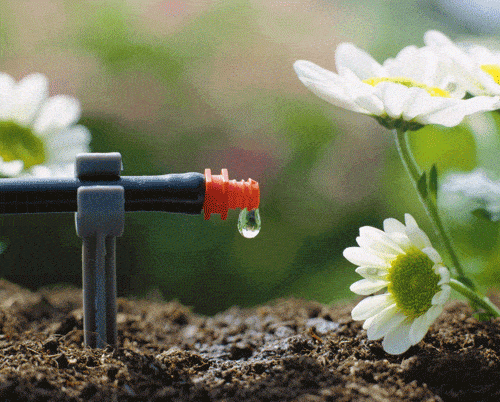
In the post Installing a drip irrigation system we saw how to mount this irrigation in the orchard.
2. Furrow irrigation
It is one of the most traditional types of irrigation, although the use of water is much less efficient (you spend more to irrigate the same thing), it is still effective (the water reaches the roots well since it keeps wetting the nearby soil). to them).
You must be in good shape and have a little agility with the handling of the garden tools to dig and make the furrows of your garden each season, as Sandra taught us in this cool video on our Agrohuerto TV channel:
3. Sprinkler and micro-sprinkler irrigation
The aerial part of the plants gets wet, so you have to be careful with fungi, but it is interesting in the fight against some pests such as thrips, since these insects are bothered by the water falling on them and they leave the plants.
The system is slightly more complex than the drip system and therefore somewhat more expensive. The amount of water used with this method is greater, but there is still a water saving compared to other types of irrigation such as furrow irrigation.
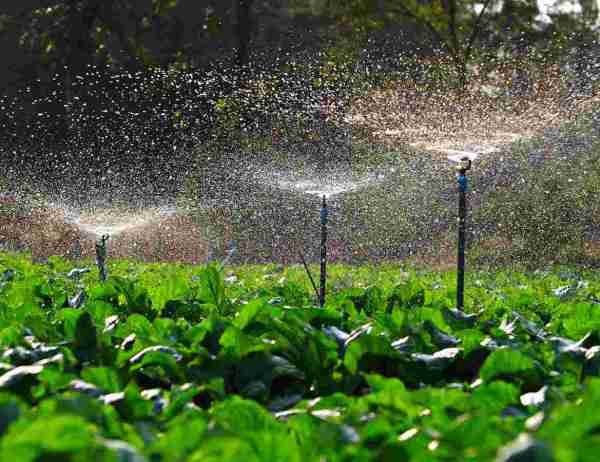
The micro-sprinkler system is a variant of sprinkler irrigation but, as you can imagine, on a smaller scale. The curtains of water expelled by the sprinklers do not have such a great range, so it spends less water to achieve the same. For the orchard it is perfect since vegetables have little volume, so micro-sprinklers will suffice.
Also broadcast irrigation is very similar, with the difference that the propelled water droplets are much smaller. It is like a nebulization, which makes the humidity of the plant’s environment higher. It can be interesting for those crops that require high levels of humidity.
4. Blanket or flood irrigation
The advantages of this type of irrigation are its low cost and its simplicity (irrigation pipes are not necessary, nor do you have to make furrows…).
In addition, blanket irrigation is very useful for watering orchards on slopes, although the problem is that a lot of water is used, especially if it is not used or reused.
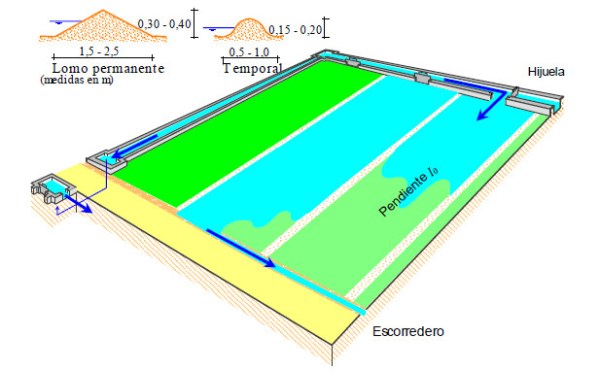
Another disadvantage is that it favors erosion (the earth can be dragged by the water when it descends), so the structure of the soil, so important for the roots, is altered.
5. Irrigation by exudation or with exudation tape
The exuding tape irrigation is less known than other types of irrigation but it is highly recommended. Saving water and its efficient use is one of the most important advantages (in this aspect it is similar or even greater than drip irrigation).
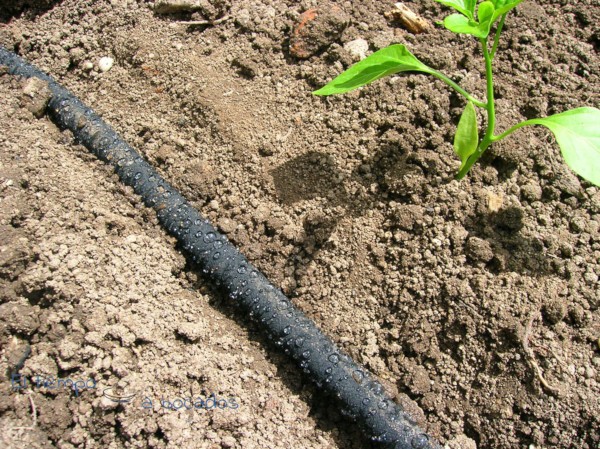
It consists of flattened porous tubes or conduits through which water circulates, like dripping, but which expel small drops along their entire length.
In addition to saving water, this system has other advantages, such as the fact that the tubes can be buried, improving the aesthetics of the orchard. Also, unlike drip irrigation, it is not necessary to change the location of the holes every year, when we rotate crops and the plants are located in different places, since water is expelled throughout the entire tube.. For this reason, irrigation is very homogeneous even for orchards on slopes.
6. Self-watering home irrigation system (holiday watering)
I won’t dwell too much on this as Sandra told us about several systems that can be used to water the garden or flowerbed if we are not home for several days or weeks. You can find more information about these types of irrigation in the post « Irrigation on vacation » and in this video:
In future Agrohuerto posts we will give more details about some of these types of irrigation that we have not yet discussed in depth on the blog. You can find more information about all this by typing the word “irrigation” or “types of irrigation” in the search engine above.
I hope you find it useful! Any questions, clarification or advice you want to give us, you already know that’s what the comment thread below is for!
References
- Legarda Burbano, L. et al., 2000. Exudation irrigation: description, characteristics and advantages of the system. Journal of Agricultural Sciences, vol. 17 (1), p. 355-361.
- Fernández Gómez, R., et al, 2010. Irrigation manual for farmers: module 4. Localized irrigation. Ministry of Agriculture and Fisheries of the Junta de Andalucía, Spain.
- Santos Pereira, L. et al., 2010. Irrigation and its technologies. CEER – Center for Biosystems Engineering, Higher Institute of Agronomy, Technical University of Lisbon, Portugal. 1st Edition in Casellano published by CREA-UCLM (Regional Center for Water Studies, University of Castilla-La Mancha, Spain).
- Demin, PE, 2014. Contributions to improve the management of irrigation systems. Irrigation Methods: Fundamentals, Uses, and Adaptations. National Institute of Agricultural Technology. Catamarca Regional Center, Argentina.
- Playán Juvillar, E. et al., 2014. Techniques for saving water and energy on the plot. Technical Seminar on the Canal de Aragón and Cataluña: Energy Innovation in Irrigation (Binéfar, Huesca. March 19, 2014).

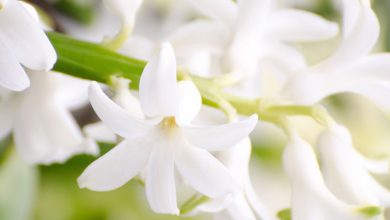
![Photo of Potted Olive Tree Care: [Soil, Humidity, Pruning and Problems]](https://www.complete-gardening.com/wp-content/uploads/2022/08/potted-olive-tree-care-soil-humidity-pruning-and-problems-390x220.jpg)
![Photo of Kalanchoe Care: [Soil, Humidity, Pruning and Problems]](https://www.complete-gardening.com/wp-content/uploads/2022/08/kalanchoe-care-soil-humidity-pruning-and-problems-390x220.jpg)
